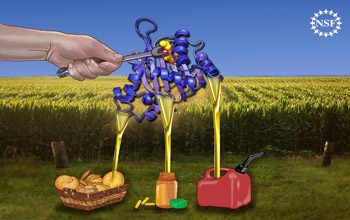News Release 12-090
Cellular Secrets of Plant Fatty Acid Production Understood
Chalcone-isomerase protein holds much promise of economic benefit
May 13, 2012
This material is available primarily for archival purposes. Telephone numbers or other contact information may be out of date; please see current contact information at media contacts.
A curious twist in a family of plant proteins called chalcone-isomerase recently was discovered by Salk Institute for Biological Studies scientist Joseph Noel and colleagues at Iowa State University led by Eve Wurtele.
Pursuing basic scientific discovery, they found three similar proteins that could soon translate into positive results for bio-renewable fuels, commodity chemicals like plastics, food security and nutrition and biomedicine.
The findings, reported May 13 in the advance online publication of the journal Nature, may lead to higher-yield crops and quantities of oils, help to address growing world demands for food and fuel, and mitigate environmental pressures on stressed ecosystems.
Researchers long wondered about the origin and action of the chalcone-isomerase. They knew it played a key role in producing flavonoids--compounds important to plants for many reasons, including defense as natural sunscreens and antibiotics, as well as attraction of pollinators and development.
Flavonoids are also seen as valuable in disease prevention agents as "nutraceuticals" and in plant-rich diets employed in fighting cancer and other age-related diseases.
Looking into the evolution of the plant protein, the researchers discovered three chalcone-isomerase "cousins" that bind fatty acids.
"This is a beautiful study demonstrating that chalcone-isomerase arose from another important class of proteins, which have no enzymatic activity but bind fatty acids," said Greg Warr, acting deputy director of the National Science Foundation's Division of Molecular and Cellular Biosciences, which funded the study.
"The findings may have important implications for agriculture and biofuel development."
Researchers found the chalcone-isomerase cousins clustered in something called chloroplasts, specialized parts of a cell that serve as the engines of photosynthesis, but are also the key place for making essential fatty acids, including omega-3 fatty acids.
Fatty acids, such as omega-3s, are as important to both plant and human well-being as the flavonoids. Noel and colleagues' research shows that bringing about changes in the genes that encoded for the chalcone-isomerase cousins produced reproductive changes in plants.
Bringing about changes in the genes for this protein family had an effect on seed oil content, something vital for the energy stores of the plant embryo but also for human nutrition and new kinds of renewable fuels.
As the benefits of over a decade of basic research on chalcone-isomerase are reaped, biologists look forward to opening the door for bio-engineers. Armed with the structures of the four proteins, bio-engineers will be able to adjust the plant cellular factory for fatty acid production to the advantage and benefit of agriculture as well as the fields of renewable energy, biorenewable chemicals and biomedicine.
-NSF-
Media Contacts
Bobbie Mixon, NSF, (703) 292-8485, email: bmixon@nsf.gov
Jennifer L. Michalowski, Howard Hughes Medical Institute, 301-215-8576, email: michalow@hhmi.org
Program Contacts
Gregory Warr, NSF, (703) 292-8440, email: gwarr@nsf.gov
Principal Investigators
Eve Wurtele, Iowa State University, (515) 294-8989, email: mash@iastate.edu
Joseph P. Noel, Howard Hughes Medical Institute, (858) 453-4100, email: noel@salk.edu
The U.S. National Science Foundation propels the nation forward by advancing fundamental research in all fields of science and engineering. NSF supports research and people by providing facilities, instruments and funding to support their ingenuity and sustain the U.S. as a global leader in research and innovation. With a fiscal year 2023 budget of $9.5 billion, NSF funds reach all 50 states through grants to nearly 2,000 colleges, universities and institutions. Each year, NSF receives more than 40,000 competitive proposals and makes about 11,000 new awards. Those awards include support for cooperative research with industry, Arctic and Antarctic research and operations, and U.S. participation in international scientific efforts.
Connect with us online
NSF website: nsf.gov
NSF News: nsf.gov/news
For News Media: nsf.gov/news/newsroom
Statistics: nsf.gov/statistics/
Awards database: nsf.gov/awardsearch/
Follow us on social
Twitter: twitter.com/NSF
Facebook: facebook.com/US.NSF
Instagram: instagram.com/nsfgov

